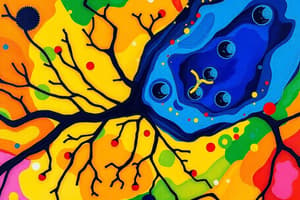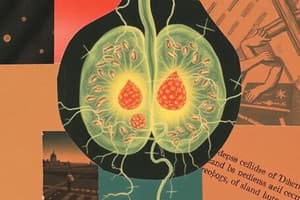Podcast
Questions and Answers
How many molecules of ATP are produced from one complete turn of the Krebs cycle?
How many molecules of ATP are produced from one complete turn of the Krebs cycle?
- 1 molecule (correct)
- 4 molecules
- 3 molecules
- 2 molecules
Which of the following products is generated in the highest quantity during the complete breakdown of one glucose molecule through glycolysis and the Krebs cycle?
Which of the following products is generated in the highest quantity during the complete breakdown of one glucose molecule through glycolysis and the Krebs cycle?
- Reduced NAD (correct)
- CO2
- Reduced FAD
- ATP
During the Krebs cycle, how many molecules of CO2 are released for each glucose molecule metabolized?
During the Krebs cycle, how many molecules of CO2 are released for each glucose molecule metabolized?
- 8 molecules
- 4 molecules (correct)
- 2 molecules
- 6 molecules
Which compound is not produced during the glycolytic pathway?
Which compound is not produced during the glycolytic pathway?
How many turns of the Krebs cycle occur per glucose molecule during its metabolism?
How many turns of the Krebs cycle occur per glucose molecule during its metabolism?
What is the primary product of anaerobic respiration in muscles?
What is the primary product of anaerobic respiration in muscles?
How many ATP molecules are produced during anaerobic respiration?
How many ATP molecules are produced during anaerobic respiration?
Which of the following is a product of ethanol fermentation in yeast?
Which of the following is a product of ethanol fermentation in yeast?
Where does aerobic respiration primarily occur in eukaryotic cells?
Where does aerobic respiration primarily occur in eukaryotic cells?
What is the byproduct of aerobic respiration?
What is the byproduct of aerobic respiration?
What is produced during alcoholic fermentation?
What is produced during alcoholic fermentation?
What type of respiration occurs in the absence of oxygen?
What type of respiration occurs in the absence of oxygen?
Which type of fermentation occurs in mammalian muscle tissue?
Which type of fermentation occurs in mammalian muscle tissue?
What is the byproduct of glucose breakdown during lactic acid fermentation?
What is the byproduct of glucose breakdown during lactic acid fermentation?
Which organism primarily undergoes alcoholic fermentation?
Which organism primarily undergoes alcoholic fermentation?
How many molecules of NADH are produced in the initial stages of anaerobic respiration?
How many molecules of NADH are produced in the initial stages of anaerobic respiration?
In anaerobic respiration, what is the main purpose of fermentation?
In anaerobic respiration, what is the main purpose of fermentation?
Which molecule is not a product of alcoholic fermentation?
Which molecule is not a product of alcoholic fermentation?
What is one function of the outer smooth membrane of the mitochondria?
What is one function of the outer smooth membrane of the mitochondria?
What structure within the mitochondria contains ribosomes and DNA?
What structure within the mitochondria contains ribosomes and DNA?
Which metabolic process occurs in the cytoplasm?
Which metabolic process occurs in the cytoplasm?
What role do the stalked particles found in the cristae serve?
What role do the stalked particles found in the cristae serve?
Which statement accurately describes the inner folded membrane of the mitochondria?
Which statement accurately describes the inner folded membrane of the mitochondria?
What are cristae primarily involved in?
What are cristae primarily involved in?
What type of enzymes are primarily found in the mitochondrial matrix?
What type of enzymes are primarily found in the mitochondrial matrix?
What characterizes the mitochondrial DNA compared to nuclear DNA?
What characterizes the mitochondrial DNA compared to nuclear DNA?
What is the primary energy yield from glycolysis during anaerobic respiration?
What is the primary energy yield from glycolysis during anaerobic respiration?
In lactic acid fermentation, which compound acts as the final hydrogen acceptor?
In lactic acid fermentation, which compound acts as the final hydrogen acceptor?
What does lactate convert back into once oxygen supply is resumed?
What does lactate convert back into once oxygen supply is resumed?
What is the fate of lactate after it is produced during anaerobic respiration?
What is the fate of lactate after it is produced during anaerobic respiration?
What is the reason for muscle fatigue and cramps during anaerobic respiration?
What is the reason for muscle fatigue and cramps during anaerobic respiration?
What term describes the extra oxygen needed to break down lactate after exercise?
What term describes the extra oxygen needed to break down lactate after exercise?
What is the primary reason anaerobic respiration is used by muscles?
What is the primary reason anaerobic respiration is used by muscles?
Why are enzymes crucial in metabolic pathways?
Why are enzymes crucial in metabolic pathways?
Flashcards are hidden until you start studying
Study Notes
Mitochondria Structure
- Double membrane: Outer smooth membrane is permeable to small molecules needed for cellular respiration (e.g., pyruvate). The inner folded membrane forms finger-like cristae projecting into the matrix.
- Cristae: Contain stalked particles which contain respiratory enzymes.
- Matrix: Contains ribosomes and DNA. Also contains soluble enzymes for cellular respiration.
Stages of Respiration
- Glycolysis: Takes place in the cytoplasm.
- Kreb's cycle (citric acid cycle/ tricarboxylic acid cycle): Takes place in the matrix of mitochondria.
- Each turn of the Krebs cycle produces:
- 2 molecules of CO2
- 1 molecule of ATP
- 3 molecules of reduced NAD
- 1 molecule of reduced FAD
- Each turn of the Krebs cycle produces:
- ATP (adenosine triphosphate) synthesis by Chemiosmosis: Occurs in the inner mitochondrial membrane. Protons (H+) are pumped across the membrane from the matrix to the intermembrane space, creating a concentration gradient. This gradient drives the movement of protons back into the matrix through ATP synthase, generating ATP.
Anaerobic Respiration
- Occurs in the absence of oxygen.
- Two types:
- Alcoholic fermentation: Occurs in yeast and roots of plants in waterlogged soil. Produces ethanol, carbon dioxide, and energy (glucose -> ethanol + carbon dioxide + energy).
- Lactic acid fermentation: Occurs in mammalian muscle tissue. Produces lactic acid and energy (glucose -> lactic acid + energy).
Importance of Anaerobic Respiration in Muscles
- When oxygen supply fails to meet muscle demand, muscles respire anaerobically.
- Lactic acid produced lowers the pH and can inhibit muscle enzymes, causing muscle fatigue and cramps.
- Once oxygen supply is resumed, lactate is converted back into pyruvate for the Krebs cycle or transported to the liver for breakdown or storage as glycogen.
- Extra oxygen needed to breakdown lactate is known as "oxygen debt".
Metabolic Pathways and Enzymes
- Many cellular respiration reactions occur through metabolic pathways where each step is catalyzed by a specific enzyme.
- Enzymes lower the activation energy required for the reactions to take place.
- Glucose is broken down into pyruvate through a series of steps, each with a specific enzyme.
Cellular Respiration Flowchart
- Glucose is initially broken down via glycolysis to produce pyruvate.
- In anaerobic conditions, pyruvate is further broken down to either ethanol and CO2 (alcoholic fermentation) or lactic acid (lactic acid fermentation).
- In aerobic conditions, pyruvate enters the mitochondria to undergo the Krebs cycle and oxidative phosphorylation.
- This process generates a significant amount of ATP, CO2, and water.
Studying That Suits You
Use AI to generate personalized quizzes and flashcards to suit your learning preferences.




